
At a Glance
Time Needed: 60 min.
Ages: All
Allows Food/Drink: No
Luggage Storage: No
39 Battery Pl, New York, NY 10280 Get Directions
The Skyscraper Museum Videos
Industrial historian MARY HABSTRITT discusses New York's rich industrial heritage and ongoing preservation efforts. Hasbritt was a consultant for VUF and is the director of the LILAC Preservation project, a decommissioned U.S. Coast Guard vessel that served as a lighthouse tender. She also contributed to the Save Brooklyn's Industrial Heritage website of the Municipal Art Society.
Manufacturers discuss their space and the industrial squeeze in New York. The evening featured Jonathon Taylor and Stephen Lynch of Caliper Studios, Williamsburg; Michael Tower of Studio Tractor, Brooklyn; and Joseph Sultan of Chilewich, Manhattan.
Completed in 1960, Milan’s Pirelli Tower, or Grattacielo Pirelli, was the tallest building in the Northern Italian city. Designed by the leading Italian modernist Giò Ponti in collaboration with the renowned structural engineer Pier Luigi Nervi, the Pirellone, or “Big Pirelli," was constructed of concrete, like nearly all Italian and European high-rises. Join us on July 26 at 4pm ET (2 hours earlier than our usual start time) for a talk by Marko Pogacnik, a professor at the University Iuav Venezia, on the Grattacielo Pirelli and the postwar Italian skyscraper. Our series In Situ: The Modern Concrete Skyscraper turns the spotlight from the U.S. to Europe. As Pogacnik will illustrate, the war-ravaged city of Milan in the 1950s witnessed a strong desire for urban renewal, manifested in the construction of a series of tall buildings: Torre Breda 1950-55; Torre Velasca 1955-58; and Torre Galfa 1956-59. At 32 stories and 127m/417 ft., the outstanding building of this postwar boom in both height and artistic achievement was the Pirelli Tower. In it, architect Giò Ponti and structural engineer Pier Luigi Nervi, with Arturo Danusso, sought to establish a distinctive Made-in-Italy skyscraper that abandoned the standard American approach of the steel frame in favor of the use of reinforced concrete in the form of heavy partitions and expressive structure. Professor Pogacnik will illustrate the modernist principles propounded by Giò Ponti and the inspired collaboration with Nervi and Danusso. After his presentation, he will converse with Tom Leslie, author of Beauty's Rigor: Patterns of Production in the Work of Pier Luigi Nervi (2017). Marko Pogacnik Marko Pogacnik is Full Professor at the University Iuav Venezia. He has investigated the links between Engineering and Architecture, one of his main scientific interests, in the works of: Gottfried Semper, Mies van der Rohe, Le Corbusier, Adalberto Libera, and Carlo Scarpa. He was Visiting Professor at the University Innsbruck, TU Dortmund, and TU Kaiserslautern, among others. Thomas Leslie, FAIA Thomas Leslie is Professor of Architecture at the University of Illinois Urbana-Champaign where he researches the integration of building sciences and arts, both historically and in contemporary practice. He is the author of Chicago Skyscrapers, 1871-1934 and its sequel Chicago Skyscrapers, 1934-1986 (Champaign: University of Illinois Press, 2013 and 2023). #TheSkyscraperMuseum #NewYorkCity #Chicago #Milan #Italy #Architecture #Construction #Urbanism #Skyscraper #Lecture #Museumfromhome #MarkoPogacnik #ThomasLeslie #CarolWillis #PirelliTower
On June 26, 2018, The Skyscraper Museum presented the 2018 Making New York History Award to Marc Holliday, CEO of SL Green Realty Corp. As New York City’s largest owner of commercial office properties and the dominant landlord in Midtown Manhattan, SL Green owns a portfolio of skyscrapers that embraces both landmark structures and classic modern towers. Now on the rise is One Vanderbilt, midtown's future tallest office building. Led by Marc's vision, SL Green is creating a new icon on the skyline.
More in Financial District
More Museums
- The Tenement Museum
- New Museum
- International Center of Photography
- Museum at Eldridge Street
- National Museum of the American Indian
- National September 11 Memorial & Museum
- The Rubin Museum of Art
- Whitney Museum of American Art
- The Morgan Library & Museum
- Museum of Modern Art (MoMA)
The Skyscraper Museum Frequently Asked Questions
The closest subway stops to The Skyscraper Museum at 39 Battery Pl in New York City are:
1. Bowling Green (4, 5 trains): Located just a short walk away from the museum, this subway stop is convenient for visitors coming from various parts of the city. You can check the latest subway updates and schedules at the official MTA website: http://www.mta.info.
2. Whitehall St-South Ferry (1, R, W trains): Another nearby subway stop, Whitehall St-South Ferry provides easy access to The Skyscraper Museum. Be sure to check for any subway service changes or delays before your visit.
While you're in the area, I recommend checking out some other attractions and dining options nearby:
1. Battery Park: Enjoy a stroll through Battery Park, located right by The Skyscraper Museum. This beautiful waterfront park offers stunning views of the Statue of Liberty and is a great spot to relax and soak in the atmosphere.
2. Statue of Liberty and Ellis Island: If you have the time, consider taking a ferry ride to visit the Statue of Liberty and Ellis Island. These iconic landmarks are a must-see for any visitor to New York City. You can find more information and purchase tickets at the official website: https://www.nps.gov/stli/index.htm.
3. Stone Street: For a unique dining experience, head over to Stone Street, a historic cobblestone street lined with restaurants and outdoor seating. It's a great place to grab a bite to eat and enjoy the lively atmosphere.
I hope you have a fantastic time exploring The Skyscraper Museum and the surrounding area!
The closest bus stops to The Skyscraper Museum at 39 Battery Pl in New York City are:
1. South End Avenue/West Thames Street - served by the M20 bus. You can check for updates on the M20 bus schedule [here](http://bustime.mta.info/m/index?q=400293).
2. South End Avenue/Albany Street - served by the M9 bus. You can check for updates on the M9 bus schedule [here](http://bustime.mta.info/m/index?q=400291).
These bus stops are conveniently located near The Skyscraper Museum, making it easy to reach the museum by public transportation. Enjoy your visit!
The ideal length of time to plan for a visit to The Skyscraper Museum in New York City is approximately 1 to 2 hours. This should give you enough time to explore the museum's exhibits, learn about the history and development of skyscrapers, and appreciate the architectural wonders on display. However, if you are particularly interested in the subject matter or enjoy reading detailed information, you may want to allocate a bit more time to fully immerse yourself in the museum's offerings. Remember, it's always better to have a little extra time than to feel rushed during your visit. Enjoy your time at The Skyscraper Museum!
The Skyscraper Museum in New York City does not have a food or drink policy. However, please note that food and drinks are not allowed in the exhibition galleries. If you're looking for a bite to eat or a refreshing drink, there are plenty of restaurants and cafes in the surrounding area where you can enjoy a meal before or after your visit.
The Skyscraper Museum in New York City does not have a luggage storage facility. However, there are several options available nearby where you can securely store your luggage while you visit the museum.
One option is to use a luggage storage service. There are several companies in the city that provide this service, allowing you to drop off your bags at a designated location and pick them up later at your convenience. Some popular luggage storage services in New York City include LuggageHero, Vertoe, and Schwartz Luggage Storage.
Another option is to check if your hotel offers luggage storage for guests. Many hotels in the city provide this service, allowing you to store your bags before check-in or after check-out. It's always a good idea to contact your hotel in advance to inquire about their luggage storage policy.
Lastly, if you are visiting other attractions or museums before or after your visit to The Skyscraper Museum, you can check if they offer luggage storage facilities. Some larger museums and tourist attractions in New York City provide lockers or coat check services where you can store your belongings.
Remember to plan ahead and consider your options to ensure a hassle-free visit to The Skyscraper Museum and other attractions in the city.
Yes, The Skyscraper Museum in New York City is definitely worth a visit for visitors from other countries and non-English language speakers. While the museum primarily provides information in English, they do offer free audio guides in multiple languages, including Spanish, French, German, Italian, and Japanese. These audio guides provide detailed explanations about the exhibits and the history of skyscrapers, ensuring that visitors can fully appreciate the museum regardless of their language proficiency.
Additionally, the museum's exhibits are visually engaging and showcase the fascinating evolution of New York City's skyline. From scale models and architectural drawings to interactive displays, there is plenty to see and learn about the iconic skyscrapers that define the city's skyline. Even without understanding the accompanying texts, visitors can still appreciate the impressive visuals and gain a deeper understanding of the architectural marvels that make New York City unique.
Overall, The Skyscraper Museum offers an enriching experience for visitors of all backgrounds, making it a great attraction to explore during your time in New York City.
The Skyscraper Museum in New York City is a fascinating destination for visitors of all ages. While there is no specific recommended age range, the museum's exhibits and displays are designed to engage and educate visitors of all backgrounds and interests. Whether you are a history buff, an architecture enthusiast, or simply curious about the iconic skyscrapers that define New York City's skyline, you will find something of interest at this museum. Families with children can also enjoy the interactive exhibits and learn about the evolution of skyscrapers through fun and educational activities. So, no matter your age, don't miss the opportunity to explore the world of skyscrapers at The Skyscraper Museum!
Videos
TICKET CENTRAL
Recommended For You













 SHOP BROADWAY
SHOP BROADWAY